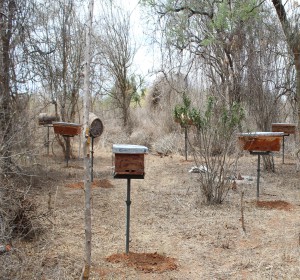
Research Centre: Icipe Barnongo,icipe Kitui
Principal Researcher: SubramaniIan Sevgan and Nelly Ndung’u
Research Background:
In addition to producing honey, bees play an important role as pollinators of crops, pastures, and trees, thus contributing to food security, environmental conservation, and climate change adaptation through the availability of carbon sinks. It is estimated that Kenya produces about 11,000 metric tonnes of honey and 1- 3 tonnes of beeswax annually.
This is about 20% of the country’s potential and the low production is attributed to a lack of appropriate technologies, poor beekeeping practices, low uptake of improved technologies, poor policy guidelines, and marketing skills. Many of the arid and semi-arid counties of Kenya have huge potential for the production of hive products. However, existing beekeeping technologies are not suitable in a changing climate of increased temperatures and low moisture situations.
The superiority of log hives in beekeeping among pastoral communities is well established and continues to prevail with changing climatic conditions in arid and semi-arid lands. A recent survey among some beekeeping communities in Baringo County (e.g. Arabel area) showed that all Langstroth and Kenya Top bar hives were empty. Emerging honey pests and diseases are another challenge.
Thus the productivity of honey is low, making Kenya unable to meet domestic and export demand. Research activities for climate-smart bee-keeping technologies were undertaken by icipe as a co-applicant in this Action. This included the following sub-activities.
Research Objectives:
- Develop and validate new hive innovations and best management practices to enhance occupancy and increase yield.
- Develop strategies for the conservation of threatened bee habitats.
Achievements:
BMPs identified from literature
The best
management practices have been identified from the literature and summarised in
a training workbook/ manual. Using the training manuals, farmers from Kitui and
Baringo have been trained on the BMPs in apiculture. The beekeepers have been
trained in subsequent data collection, in their farms with the help of
technicians from KAMAKI in Kitui and KALRO in Baringo. The information is kept
in records by the two technicians.
Participatory
on-farm research established for analysis of hive-type suitability in different
agroecological zones of the ASAL incl. establishment of a floral calendar.
Locally
constructed hives were bought in both Kitui and Baringo, and were distributed
to the 16 selected farmers in both sites. In addition, other beekeeping
equipment were distributed to the farmers including, hive tools, bee suits and
phones to communicate with their respective technicians. The analysis of hive
suitability was done for both sites, we discovered that Langstroth, KTBH and
Special log hive were the best for Kitui while KTBH and Langstroth hive were
colonised in Baringo. This was indicated by the rate of absconding and
colonisation, and the rate of pest infestation. Spiders, ants, wasps lizards
and rats were among the commonly recorded pests and predators in both sites.
The honey badger was the most destructive predator in both sites.
The floral
resources were recorded for both sites, it was noted that in Baringo, Acacia
spps and Prosopis spp were the most prevalent forage plants for the
bees. Whilst in Kitui, food crops and Acacia spp were the most prevalent. This
could be one of the reasons why the drought experienced in Kitui affected the
survival and colonisation rate of the hives. The analysis for continuous
follow-up after training will be done using the economic survey tools, through
ICIPE Socio-economic unit. This activity will only be carried out in Kitui
where the project has been undertaken since 2019.
Determination
of optimal time point of honey harvest for increased yields
Indigenous
knowledge about the optimal harvest time has been collected using the
questionnaires, it was noted that for Baringo, harvesting occurs in December
while in Kitui harvesting occurs in March, June and Dec. The data for
harvesting and weather will determine the best seasons for harvest.
Capacity
building of KALRO-ARI staff-Baringo specific
Oral and practical
training were carried out in 2022 for the KALRO staff in Baringo mostly
regarding Best Management Practices, bee handling while working on the hives
and collection of the pollen for research purposes.
Further more
advanced trainings were carried out in ICIPE, mostly in honey quality analysis.
Related Research Activities

